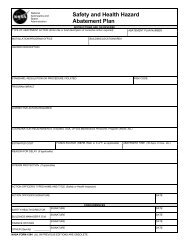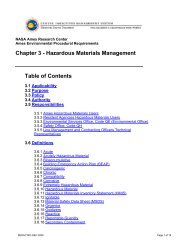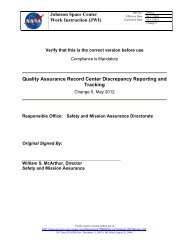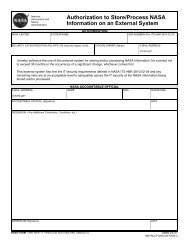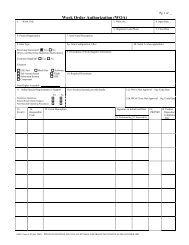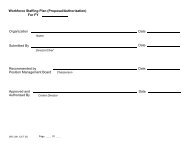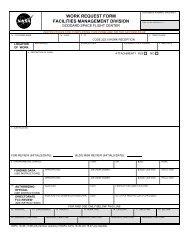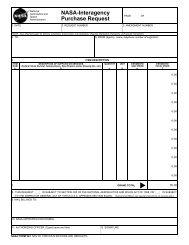JPR 8550.1 - Nasa
JPR 8550.1 - Nasa
JPR 8550.1 - Nasa
Create successful ePaper yourself
Turn your PDF publications into a flip-book with our unique Google optimized e-Paper software.
JSC Environmental Compliance<br />
Procedural Requirements<br />
<strong>JPR</strong> No.<br />
<strong>8550.1</strong>A XXXX.X<br />
Effective Date:<br />
Johnson Space Center • Environmental Compliance Program<br />
Expiration Date:<br />
Expiration Date:<br />
Page Number<br />
3/25/2011<br />
3/25/2016<br />
[Leave Blank]<br />
Page 110 of 123<br />
c. Accumulation times shall be kept to the minimum practical length of time for the following<br />
reasons:<br />
(1) Some chemicals become unstable or degrade over time or if exposed to heat or light;<br />
(2) Sometimes personnel changes occur and the new person can't be sure what is in a<br />
container even if it is labeled, and<br />
(3) Procedures may change and reagents or product formulations used may also change over<br />
time.<br />
14.7 Inspecting Waste Accumulation Areas<br />
The EO will inspect SAAs periodically and will identify deficiencies and document them within<br />
the Environmental Management System’s Problem Reporting System Database for action.<br />
14.8 Special Requirements for Laboratories Adding Wastes to Accumulation<br />
Containers<br />
14.8.1 The following requirements apply to laboratories:<br />
a. Do not store wastes in glass containers unless it is the only compatible material;<br />
b. Do not store wastes in laboratory vent hoods unless there is no safe alternative- hoods can<br />
be used for the transfer of wastes or chemicals to containers and for temporary observations of<br />
waste transfers to confirm that no vapors or heat are generated and the waste can be safely<br />
sealed for storage;<br />
c. When adding wastes to accumulation containers, move the container to the hood to add<br />
wastes;<br />
d. Do not immediately close the container after adding wastes - allow a few minutes to ensure<br />
that there will be no reaction that causes fumes or gas to be generated;<br />
e. Once you are sure that no gases will be generated, close the container tightly and move it to<br />
its proper storage location;<br />
f. Maintain a detailed log of all waste added to an accumulation container;<br />
g. Mix only the minimum amount of chemicals needed to do the job in order to minimize the<br />
amount of accumulated waste that will need disposal;<br />
h. Do not store/accumulate wastes for more than three months;<br />
i. Do not mix waste that contains any concentration of nitric acid with any other wastes. Nitric<br />
acid is extremely reactive, is both an oxidizer and a corrosive, and will generate heat and<br />
gases when mixed with organics and other similar materials; and<br />
j. All laboratories are required to develop and maintain a chemical hygiene plan. A qualified<br />
(degreed) chemist must conduct a review whenever new or revised laboratory procedures or<br />
Verify correct version before use at<br />
http://server-mpo.arc.nasa.gov/Services/CDMSDocs/Centers/JSC/Home.tml.<br />
JSC Form JF2420B (MS Word August 28, 2006) (Revised May 30, 2007)



